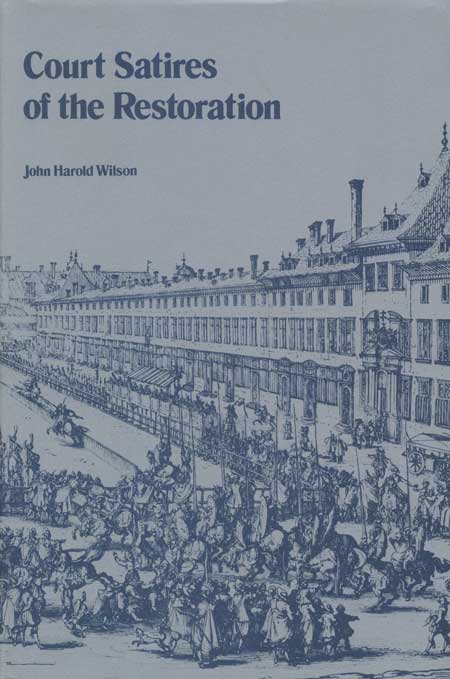| click here to read the full text of the book | leave / read comments and critiques of the book |

Court Satires of the Restoration
John Harold Wilson
Lampoons of the kind collected in this volume represented a relatively novel literary form in Restoration England, but they were to prove enormously popular among the coterie of fashionable folk who frequented the Court, strolled in the galleries of Whitehall and St. James, drove in Hyde Park, gambled in the Groom Porter’s lodgings, and thronged the playhouses of London. And to judge by contemporary gossip as it was recorded in the private letters, diaries, and memoirs of the day, the satirical Court poets were remarkably well informed about the lecheries of members of the Court and those literary and theatrical figures who, as the chief actors in notorious intrigues and scandals, became the satirists’ unfortunate victims.
Not surprisingly, most of the lampoons were circulated without an author’s name. Hardened sinners themselves, the anonymous poets were an envious, vindictive, and vicious lot, whose blatant attacks on the personal proclivities and private lubricity of their rivals and enemies made them vulnerable to various forms of legal redress, as litigants in libel suits, as well as to less ponderous, extralegal means of vengeful retribution. But though it is difficult to make specific attributions of authorship, it is possible to say who some of the satirists were. Most of them were attached to the Court in one capacity or another and in a position to pick up the gossip of the day as it circulated in the Stone Gallery, the Privy Chambers, and in nearby public houses and taverns. Others were driven to greater lengths to hear the news. According to one account, the dissolute Lord Rochester dressed a footman as a guardsman sentinel and “kept him all the winter long every night at the doors of such ladies as he believed might be in intrigues.” And one disreputable purveyor of lampoons spent his time trotting from coffee house to brothel with pockets of verses for sale, picking up the latest scandal and passing it on to a stable of poets who supplied him, in turn, with fresh libels.
The favorite devices of the satiric poets were fescennine invective, heavy-handed irony, and occasional burlesque—all written in the coarsest possible language. The simplest form of satire was a ballad or a set of verses in iambic couplets, loaded with obscene epithets and scandalous charges of outrageous behavior against those whom the poet disliked or envied or about whom there was a gossip at the moment. No one cared that the meter was often rough and the rhymes discordant; the poets aimed for liveliness, ribaldry, and vigor—and they succeeded admirably. From their scurrilous exercises in libelous bawdry was to emerge a kind of subliterature, which is interesting in itself, vastly entertaining, and often useful to the biographer and social historian, but which, more importantly, was to provide the rich soil of a tradition that was to nourish the later masterpieces of personal satire by such writers as Dryden, Swift, and Pope.
John Harold Wilson, professor emeritus of English at The Ohio State University, is the author of many previous books on the history and literature of the English Restoration, including Nell Gwyn: Royal Mistress, All the King’s Ladies, and The Ordeal of Mr. Pepys’s Clerk.
| 1976 304 pp. | This title is no longer available in a traditional print edition. Click here for free access to the book's full text. |

